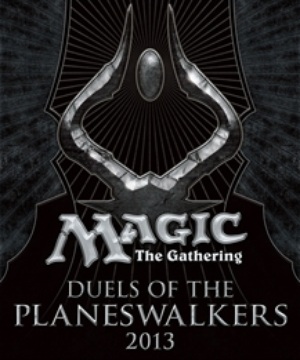
Magic the Gathering: Duels of the Planeswalkers 2013
Developer: Stainless Games
Publisher: Wizards of the Coast
Platform: XBLA (reviewed), PSN, PC, MAC, Ipad
Release Date: June 20th, 2012
Price: 800 MSP (available here), $9.99 USD on PSN, Steam and Apple store
OVERVIEW
If you’re an avid player of collectible card games, even if you don’t play it yourself, chances are you’ve heard of Magic the Gathering. In recent years, this particular card game series has found itself as popular as ever amongst audiences young and old. Part of its recent success can be attributed to the numbers of new players brought in by the Duels of the Planeswalkers series. These video game renditions of the physical MtG game have served as the starting points that have converted many curious gamers to playing actual card game itself. There’s also something for the hardcore MtG fans too, with each rendition of the DotP games offering a sneak peek at the upcoming year’s core deck releases, as well as free codes for free physical cards. Now with the third game of the series released, what new offerings does Duels of the Planeswalkers 2013 provide to players, both newbie and veteran?
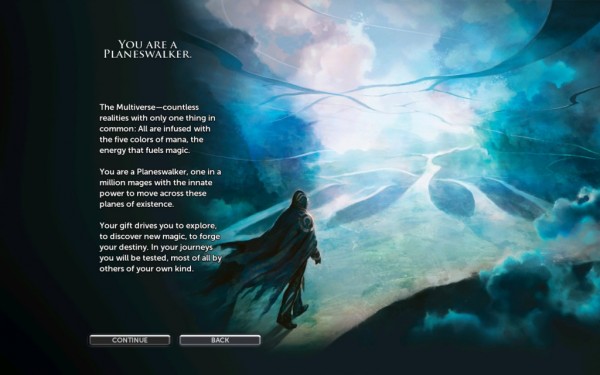
GAMEPLAY
If you’re familiar with the functioning of the physical card game, then there’s not much to be learned here. DotP 2013 follows the same set of standard rules as set out in the card game, so veterans of the series will immediately be able to jump right in. But what about the new players? It can be said that one of the biggest challenges of getting into a new game, digital, card based or otherwise is the initial barrier of learning to play. Without a mentor or guide to teach new players, interest in the game could quickly be sucked out the window. Thankfully, the digital release makes accommodations for that by providing a helpful tutorial mode, as well as game tips throughout the course of the duels.
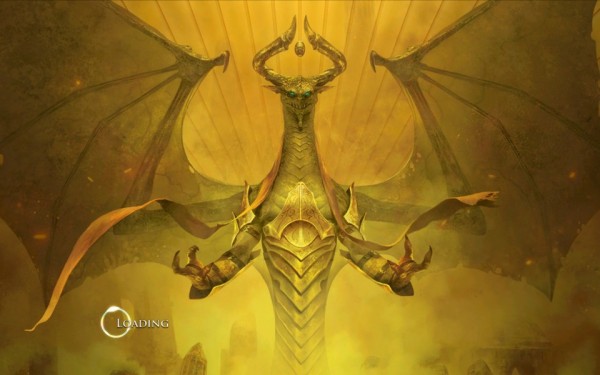
For those unfamiliar with the lore of Magic the Gathering, the main premise of the game is that the universe in MtG is made up of multiple dimensions of existence, called “Planes”. Each plane is unique in some way, but all adhere to the same physical and magical laws, namely the use of the five colours of mana. The key players of this universe are called “Planeswalkers”, a term given to a select talented few who have the ability to travel throughout these different planes. Throughout the course of the campaign, players will clash with other Planewalker personas, the most significant of whom are introduced in the opening title sequence. Many of these faces like Garruk Wildspeaker, Jace Beleren and Chandra Nalaar will be familiar to MtG veterans among some additional new faces. However it is disappointing to see several fan favourites such as Sorin Markov and Sarkhan Vol omitted from this rendition. The title sequence also introduces players to the main villain and final boss of the campaign: a Dragon Planeswalker named Nicol Bolas. This is the first time Nicol has been available to fight 1 on 1 in a duel, unlike DotP 2012, where he only existed as an Archenemy game foe.
Speaking of which, players of DotP 2012 will notice that the archenemy gametype has also been dropped from DotP 2013 in favour of another gametype called Planechase. This gametype, which has been available to the physical game for some years, essentially operates as a 4 player free for all gametype which adds special “planes” cards which have the ability to alter the course of a game through a dice roll. Now it must be said, that, despite the fun and challenge of this gametype, it unfortunately reduces much of the game down to blind luck. While this might be arguable for other portions of the game as well, the very first available level of Planechase pits the player against a pretty imbalanced set of opponents. Despite the free for all nature of this gametype, the computer controlled AIs have a tendency to gang up on the player, which make the game all the more difficult at points.
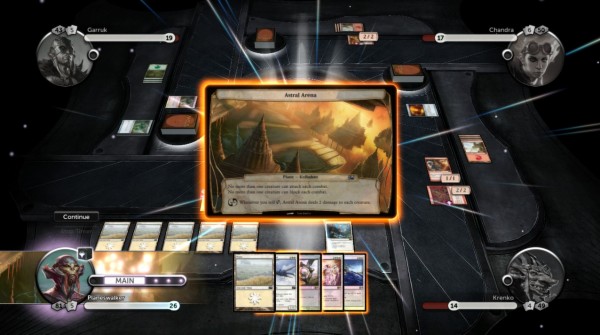
In playing the actual game itself, anyone who had played DotP 2012 will quickly recognise the duel interface as identical to that of the previous game instalment. Of course the backdrop on the duel changes from duel to duel but nothing more than that. One area of particular frustration that was unfortunately carried over from the previous game is the difficulty in interacting with the interface. Often when in a duel, players will find that the controls to look at or activate a certain card are only available at a certain point. Navigating the cursor to look at ones graveyard pile becomes an odd combination of switching scrolling controls from left thumb stick to right thumb stick at points. Moreover, it feels like the game timer has been sped up, allowing even less time for players to think and strategise on the fly. I personally preferred the interface of the first DotP game which made the player actively choose when to end their orders. While the presence of the pause button is a boon to this issue, it feels like a bandaid solution over a rather irritating interface problem.
The other issue I have with the core gameplay of DotP is the fact that much of the game will come down to pure chance half of the time. Often, players will choose to mulligan and redraw their starting hands if their initial draw is unfavourable. If it occurs multiple times with too much or too little mana, players will often have to hit ‘restart duel’, or risk playing with a few cards down. Now it is understandable why some players might need to restart once to get a decent hand, but making the player restart 10-15 times is just taking the piss. Unlike the physical card game where players can mana shuffle accordingly, the digital version very much gives off an air of: “you’ll take what you’re given and you’ll like it” mentality. Of course, part of these issues stem from the type of duellist you want to be, and how complex your deck will be structured.
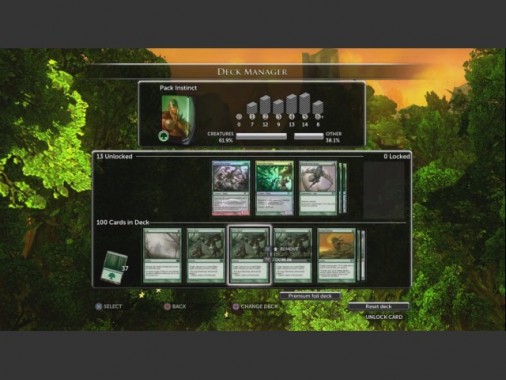
DotP 2013 features 10 brand new decks to play with, though only 2 are available from the get-go. The rest must be unlocked either buy purchasing the deck through consumable DLC, or by doing what most players will do: unlocking the decks in the campaign. There are decks for all sorts of play styles: big creatures, indirect damage, life boosting, and even milling. As for the decks themselves, it is interesting to note that 9 out of the 10 available decks are all of singular colour. Series veterans are typically wary of single coloured decks being too simplified and easily beatable by way of “protection” cards. This reviewer himself is partial to a combination of primarily red cards mixed with black, green or blue. However, for a video game franchise that has brought in new generations of players to the game of MtG, this simpler style seems like a smart move. Using simpler combinations can entice the newbie’s. However, for longer running fans of the series, there are a few benefits to be had. Any player who has downloaded both DotP 2012 and 2013 will receive a free deck key. This key is an in game consumable which can be used to either unlock access to a new deck, unlock all the bonus cards for an already available deck, or add the rare foil design to available decks to give yourself a unique look in online matches. Players will also note that this rendition of the game provides a better customization interface, allowing players to remove some of those useless high mana cost cards that yield limited benefits from the starting decks.
Altogether, there are 4 different single player gametypes to DotP 2013: Campaign, Challenges, Planechase and Revenge (which is essentially campaign on hard mode). However, no card game representation would be complete without multiplayer. Yes, Duels of the Planeswalkers 2013 supports online multiplayer. Players will be able to link with their friends for a friendly duel, or take it to online matchmaking to play against other MtG duellists from around the world.
AUDIO AND VISUAL
The musical score of Duels of the Planeswalkers 2013 is nothing to be wowed by. The soundtracks added to each duel are made to be associated with the Planewalker opponent the player is facing. For example, a dark horror type theme is added for duels against Liliana Vess and her creatures of darkness. However, players will note that the themes are often slow paced and rhythmic, with any trace of lyrics omitted entirely. Magic the Gathering is intended to be played as an intellectual challenge, so providing the right ambience is part of the music’s role. To that it, it’s quite effective, though not helped by the fast paced timer.
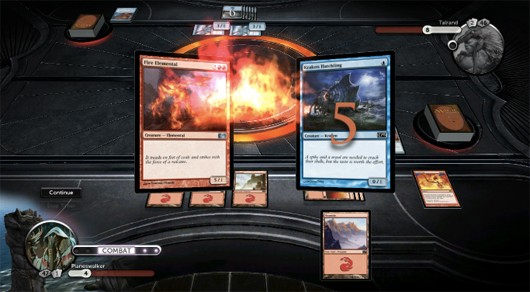
As for visuals, each card still features the classic illustrations on each card, just like on the physical card game itself. Each picture is individual and unique, providing a sense. However, the real thrill of the game comes from the added special effects. Just like the last game, the addition of sound effects and animations make the combat between a few simple playing cards seem all the more real. And it must be said it feels damn good to shove a fireball up the last life point of a particularly annoying white spell user.
OVERALL
Looking at Duels of the Planewalkers 2013 as the third in what is becoming an annually released series, I was forced to ask myself: how has this game changed things? The answer: not much. Sure the addition of Planechase and the new decks is cool, but ultimately the game has barely changed from the previous edition. It feels like DotP might be falling into the same quality trap that has befallen other annually released franchises like Fifa and Call of Duty in that each new rendition hardly differs from the last. This is not to say that the game isn’t an enjoyable experience, despite a few interface issues. However, it feels like more could have been done to evolve the series as a whole. It honestly felt exactly the same as playing DotP 2012 at points. Even so, it is a worthwhile purchase certainly for newer players, and it’s likely to draw the attention of veterans who want to try out the new season material.


